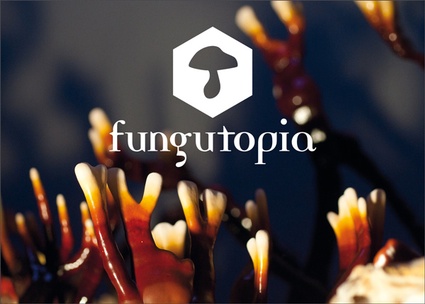
Back to Berlin where a few weeks ago i was visiting the DMY design festival. As i explained the other day, the most exciting part of the exhibition was the MakerLab where visitors could discover, discuss and handle new technologies, materials, tools, open-source ideas and concepts. In the middle of this happy creative feast, a group of smiling girls were introducing visitors to the joys of mushroom cultivation. All ‘in the comfort of their own home.’
Titled fungutopia, their work is an installation, a workshop, a prototype and a community-project.
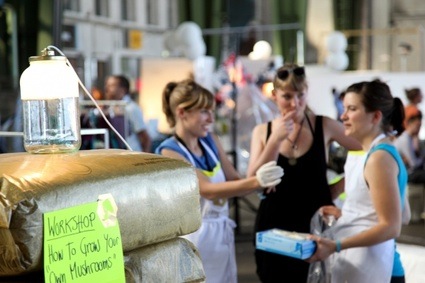 Picture by Martin Schlecht
Picture by Martin Schlecht
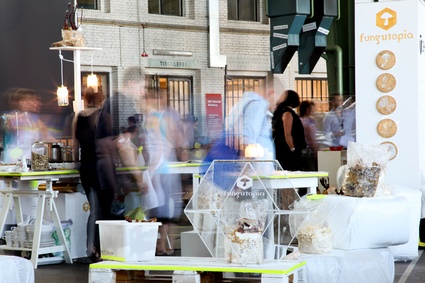 Picture by Martin Schlecht
Picture by Martin Schlecht
In installation mode, Fungutopia demonstrates that mushrooms can be used as open source medicine, food, fertilizer and soil-recovery-method. Fungutopia is also a series of hands-on workshops that teach participants how to easily cultivate mushrooms in cities, even indoor.
The project is also accompanied by the DIY MUSHroom grow kit that combines Open Source Electronics with Biology to grow even more rare medicinal species year round indoor.
Finally, fungutopia is a community-project that attempts to bring together people for urban fungiculture and share knowledge and experience.
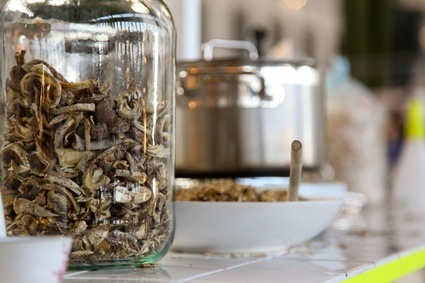 Picture by Martin Schlecht
Picture by Martin Schlecht
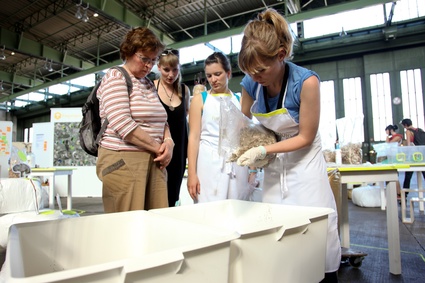 Picture by Martin Schlecht
Picture by Martin Schlecht
Laura Popplow, the creator of Fungutopia, was kind enough to answer my questions:
How did you get interested in fungi and rare medicinal species of fungi?
Fungutopia is my master thesis at the Academy of Media Arts in Cologne (in the department of hybrid space) but already started more than a year ago and will hopefully go on. I started being interested in mushrooms in general and some medical mushrooms especially because i was searching for some natural method to remediate soil of old industrial areas and because my father, who is working with cancer-patients told me about some special fungi that were very promising in cancer therapy some years ago. This came first together in the work FUNGIFICTION with Tine Tillmann.
I collaborate on the topics of medical fungis with Tine Tillmann since 2010 when we worked together on an installation about fungi as remediators of contaminated soil in the ruhr area for the ISEA2010 in Dortmund. Our collaboration there was named FUNGIFICTION and consisted of a video and a kind of science/shop/showroom installation that told the story of the RUHR REISHI, a fungus, that was left on the grounds of an old coal plant in Dortmund that was deconstructed for two years by Chinese workers. These workers left spores of the reishi, one of the most powerful medical mushrooms known especially in the Chinese traditional medicine. These reishi mushrooms not only remediated the contaminated coke plant soil, but also developed some extra-powers on this special soils. That’s why a new mushroom research center was founded on the grounds of the old coke plant area by our collaborators from the Mushroom Research Center Austria to research and find out about this surprising phenomena, that was the start of a mushroom revolution in the Ruhr area, that changed not only the quality of the soils in the old heavy industry area but also was the starting point of a social change, bringing new medical, ecological and economical wealth to the people. The biggest part of this story is actually true, it’s just some facts that we enhanced and dreamed a little further.
![]() Fungutopia at Pixelache 2001
Fungutopia at Pixelache 2001
The collaboration with Tine Tillmann grew further when we exhibited a new work-in-progress of the idea of FUNGIFICTION at the Pixelache Festival in Helsinki this March. There, we developed the idea of creating mushroom cultivation methods on old military grounds like Soumenlinna island, where the exhibition took place. in Pixelache I also exhibited a first type of modell of a MUSHroom, a growing habitat for medical mushrooms. from the starting point of a mixture of fiction and reality i took more the direction of realising the utopia (at least in small parts) whereas Tine is working even more in the direction of (science-)fiction and utopia. Both approaches are working together on the idea how mushrooms can possibly save the world.
The fungutopia station is my practical approach to get people involved in mushroom cultivation and their abilities to recycle, clean, heal and even grow material. The installation for DMY was developed together with Kyra Porada, an exhibition designer and good friend of mine. Fungutopia is part of her master thesis at the FH Düsseldorf in exhibition design.
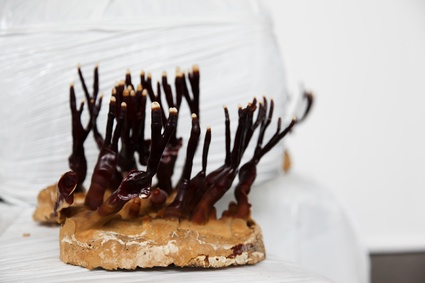 Picture by Martin Schlecht
Picture by Martin Schlecht
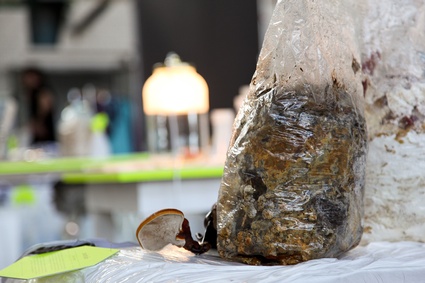 Picture by Martin Schlecht
Picture by Martin Schlecht
When i saw the fungutopia station at DMY Berlin, i was particularly surprised by the type of mushrooms you were cultivating. They are most unusual to me. Could you explain me which kind of mushrooms you cultivate and why?
The mushroom you mention is most likely known as reishi, lingh zhi or in latin ganoderma lucidum. It’s the holy mushroom in Asia, where its medical powers are known already for thousands of years. it is used in the traditional Chinese medicine against a wide range of health problems and serious diseases: its powers especially in cancer therapy have been proofed also by Western medical studies. Apart from being the most potent medical fungus, it can develop an extraordinary shape, material and colour. That was what attracted me in the first place. When i first saw some rheishi mushrooms grown in shapes you would never expect to be a mushroom I thought this is what you can really call a kind of “natural art”. Visitors tend to think it’s an artificially made sculpture.
Plus: you can influence the fungus in its shape with the amount of CO2 during its growth. The more people around the room where it grows, the more coral-like it gets.
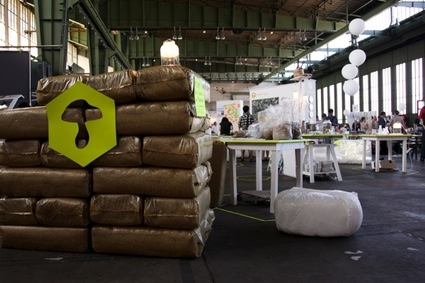 Picture by Martin Schlecht
Picture by Martin Schlecht
The text describing Fungutopia presents “mushroom culivation as a way to make the world a better place.” That’s ambitious. How can home mushroom cultivation achieve that?
There are several ways mushrooms are already helping to keep the world balanced. Mushrooms are basically the recycling system of nature. As they are an own species, they are able to “digest” which means that they transform and split up molecules. That’s how they remediate soil or can also help to filter water. The mycelium, the essential part of the mushroom, mostly hidden in the ground is a rhizomatic network that mostly lives in symbiosis with plants. Some mushrooms such as the mycorrhizia mushrooms don’t even form fruiting bodies but are working as natural fertilizers that enlarge with their rhizomatic structure the roots of the plants to get water and nutrients for them from the ground. 80-90% of all plants are living from this symbiosis. Paul Stamets, a famous mushroom cultivator describes different methods how mushrooms can save the world: as medicine, water filters, soil-remediators and even natural pesticides.
In my opinion mushrooms should be cultivated more widely in cities, because they have two characteristics that make them an ideal partner of urban agriculture: they don’t need much space and ground and they don’t need much light. Plus, they could help to clean city-soil and work as natural fertilizers for plants grown in urban agriculture.
Last but nor least: the mycelium can even produce material that could be used as isolating material in buildings. That’s what ecovative design is already doing on an industrial scale. You can grow your own forms from mushrooms- amazing isn’t it?
i believe that mushrooms could be able to help us in much more problems, we just don’t know enough about them – and we are too afraid of them. To some people they are like aliens.
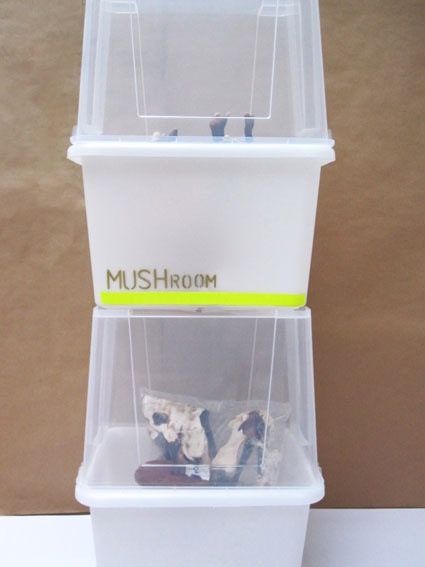 MUSHroom
MUSHroom
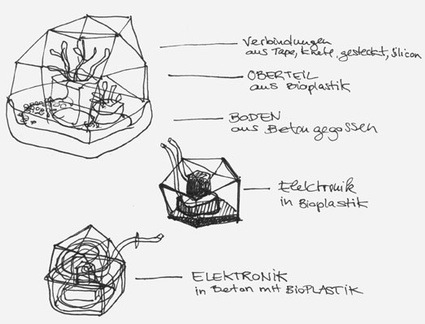 MUSHroom
MUSHroom
Could you describe me the prototype MUSHroom? What is it made of? How big is it? Are you supposed to leave it on a balcony or inside the house?
The prototype of MUSHroom is a small greenhouse with the possibility to control temperature and humidity through an arduino controller, which makes it possible to grow different mushrooms indoor. It is about 50cm X 50cm X 50cm made out of triangles and squares that form an cuboctahedron, one of the archimedean forms that were considered by Buckminster Fuller as a form of vector equilibrum. I hope to build it in the near future from plates made from bio-plastics. But so far it is made from glass or plexiglass. It’s still in its first stage of development. The idea is to develop it further as a kind of open source project with the help of the mushroomcultivator community that is also quite active online and to develop some kind of modular kit. A role model for this is the windowfarms project and its distribution model.
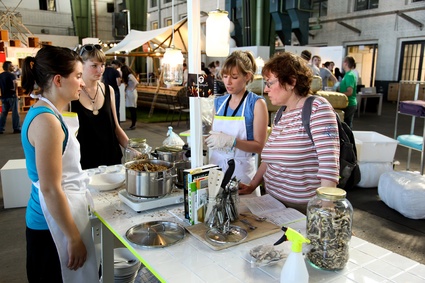 Picture by Martin Schlecht
Picture by Martin Schlecht
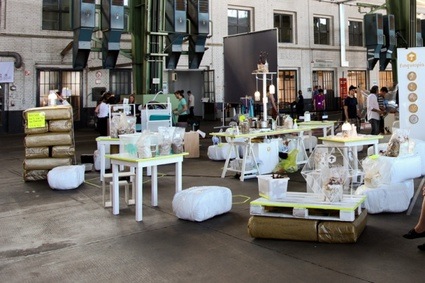 Picture by Martin Schlecht
Picture by Martin Schlecht
How much time/commitment/care does it involve to cultivate these fairly rare mushrooms?
You don’t need so much time, when you just start with a prepared substrate that you can order online in sealed plastic bags with an air filter. You will just need to take care when the fruiting bodies appear and you cut the bag to make them grow better. Then they need humidity and some of them need higher temperatures, but that depends on the species. Some of them also grow in our Western Europe climate conditions.
if you want to start your own mushroom cultivation from spores or mycelium, then you will need time to experiment and build some kind of mini laboratory with clean working conditions. But it’s still possible – lots of people are developing methods to cultivate mushrooms at home in small scale solutions as a kind of hobby. They are also the people I want to get together with the online platform grow.fungutopia.org to work on further solutions for mushrooms cultivation in cities as a kind of community project like guerrilla gardening. People should get together to build small mushrooms laboratories to deliver substrates that enable people to easily grow fresh mushrooms in their neighbour community.
Thanks Laura!
Previously: Temporary photoElectric Digestopians (Fusing Cooking and Solar Tech with Design).
